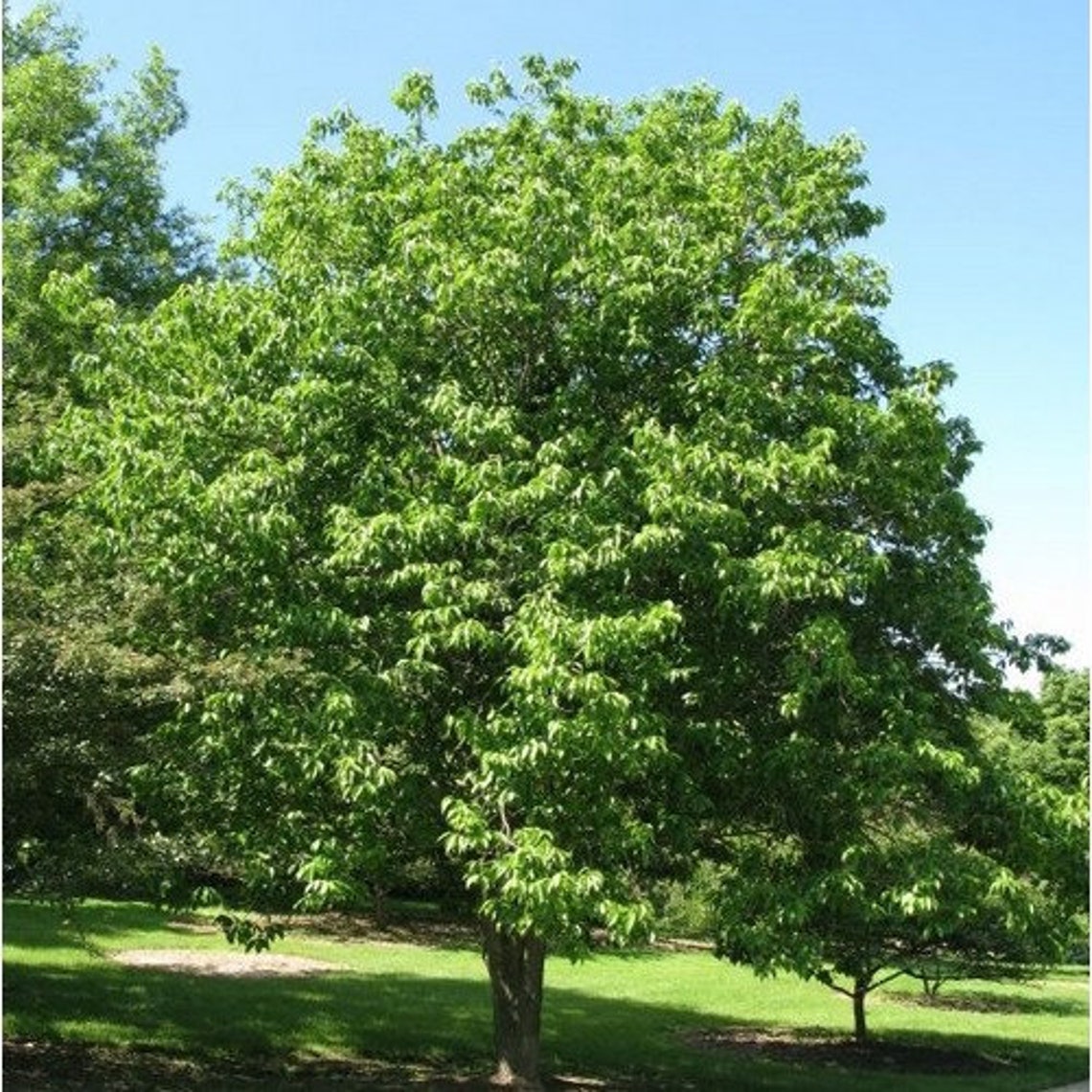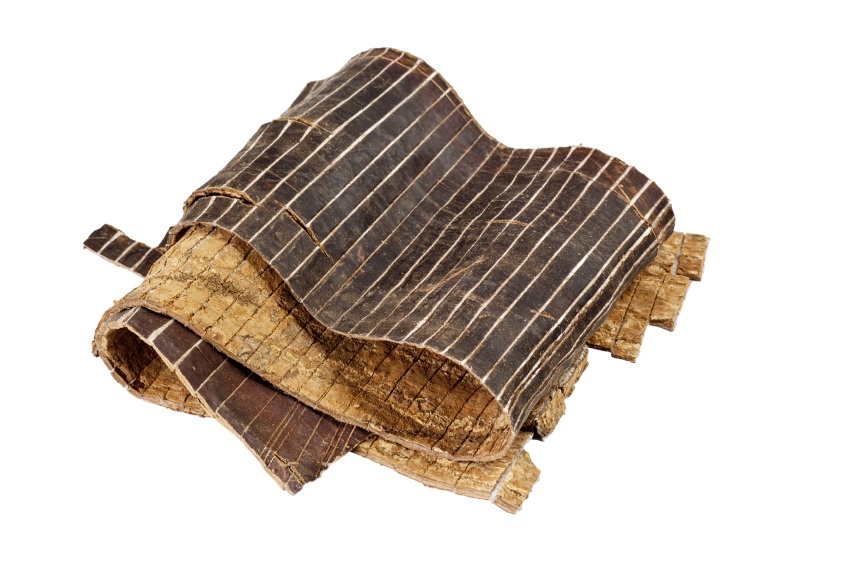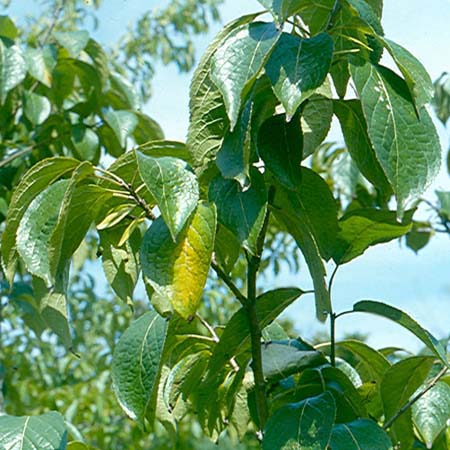 Eucommia
ulmoides. 杜
仲
Dù zhòng Eucommia,
Hardy rubber tree Family:
Eucommiaceae
Eucommia
ulmoides. 杜
仲
Dù zhòng Eucommia,
Hardy rubber tree Family:
Eucommiaceae
Eucommia is a monotypical breed, i.e. there is only one species that exists. It is a robustly growing tree that supplied rubber in China. It is the only rubber supplier in the Northern hemisphere.
It is near threatened in the wild, but is widely cultivated in China for its bark and is highly valued in Traditional Chinese medicine.
FUNCTIONS
GROUP: Tonify- Yang
1. Tonify Yang.
2. Tone up Liver and Kidney, strengthen tendons and bones.[1]
3. Secure fetus, bring down blood pressure.[2]
INDICATIONS
1. Kidney Deficiency resulting in:[1] Lumbago. Knee joint pain.[1] Weakness of muscles and lower extremities.[1] Back strain, especially due to added strain of pregnancy.[1] Weak loins.[2]
2. Theatened miscarriage resulting from overactive fetus.[1]
3. Hypertension.[2]
PATENT COMBINATIONS
PREPARATIONS: Decoction 9-15 g each dose.[1] Dried bark 6-9 g.[2]


ORIGIN: China.
DESCRIPTION: A species of small tree growing to about 15 m.
References
Inner Path can not take any responsibility for any adverse effects from the use of plants. Always seek advice from a professional before using a plant medicinally.
Research
Inhibitory Effects of Eucommia ulmoides Oliv. Bark on Scopolamine-Induced Learning and Memory Deficits in Mice.
Kwon SH, Ma SX, Joo HJ, Lee SY, Jang CG.
Abstract
Eucommia ulmoides Oliv. Bark (EUE) is commonly used for the treatment of hypertension, rheumatoid arthritis, lumbago, and ischialgia as well as to promote longevity. In this study, we tested the effects of EUE aqueous extract in graded doses to protect and enhance cognition in scopolamine-induced learning and memory impairments in mice. EUE significantly improved the impairment of short-term or working memory induced by scopolamine in the Y-maze and significantly reversed learning and memory deficits in mice as measured by the passive avoidance and Morris water maze tests. One day after the last trial session of the Morris water maze test (probe trial session), EUE dramatically increased the latency time in the target quadrant in a dose-dependent manner. Furthermore, EUE significantly inhibited acetylcholinesterase (AChE) and thiobarbituric acid reactive substance (TBARS) activities in the hippocampus and frontal cortex in a dose-dependent manner. EUE also markedly increased brain-derived neurotrophic factor (BDNF) and phosphorylation of cAMP element binding protein (CREB) in the hippocampus of scopolamine-induced mice. Based on these findings, we suggest that EUE may be useful for the treatment of cognitive deficits, and that the beneficial effects of EUE are mediated, in part, by cholinergic signaling enhancement and/or protection.
PMID: 24404337 PMCID: PMC3879918 DOI: 10.4062/biomolther.2013.074 Biomol Ther (Seoul). 2013 Nov;21(6):462-9. doi: 10.4062/biomolther.2013.074. ncbi.nlm.nih.gov
Effect of Eucommia ulmoides on systolic blood pressure in the spontaneous hypertensive rat.
Lang C, Liu Z, Taylor HW, Baker DG.
Abstract
Experiments were conducted to establish the safety and efficacy of Eucommia ulmoides (Du-Zhong) extract in the treatment of hypertension. Pilot experiments using rats demonstrated that E. ulmoides extract was safe to the saturation limits of the compound. The maximum tolerated dose (MTD) was 1200 mg/kg when administered by gastric gavage at a concentration of 1200 mg/ml. Also, rats given 200 mg/kg, 600 mg/kg or 1200 mg/kg doses of E. ulmoides extract daily for 28 days demonstrated no evidence of acute toxicity as determined by clinical appearance, histopathology and serum chemistry evaluation. Lastly, spontaneous hypertensive rats (SHRs) were administered E. ulmoides extract daily for 22 days. Systolic blood pressure (BP) was measured on treatment days 1, 8, 15 and 22 at 0, 1, 2 and 3 hours post-treatment. Beginning on day 8, E. ulmoides extract administered at the mid or high dosages lowered BP in male, but not female, rats. BP declined at a rate of approximately 10 mmHg per hour. The mid dosage of 600 mg/kg was found to be the minimum effective dose. In conclusion, E. ulmoides extract was non-toxic and effective in reducing systolic BP in the SHR.
PMID: 15974481 DOI: 10.1142/S0192415X05002795 Am J Chin Med. 2005;33(2):215-30. ncbi.nlm.nih.gov
Neuroprotective effects of Eucommia ulmoides Oliv. Bark on amyloid beta(25-35)-induced learning and memory impairments in mice.
Kwon SH, Lee HK, Kim JA, Hong SI, Kim SY, Jo TH, Park YI, Lee CK, Kim YB, Lee SY, Jang CG.
Abstract
In the present study, we examined whether aqueous extract of Eucommia ulmoides Oliv. Bark (EUE) with graded doses exerted its neuroprotective effects on amyloid beta(25-35) (Aβ(25-35))-induced learning and memory impairments in mice. Mice received a single intracerebroventricular (i.c.v.) injection of Aβ(25-35) 6 nmol as the critical factor in Alzheimer's disease (AD), cognition was evaluated using Y-maze, passive avoidance, and Morris water maze tests. EUE significantly improved the Aβ(25-35)-induced memory deficit in the Y-maze test. Also, EUE increased step-through latency time with Aβ(25-35)-induced learning and memory deficits in the passive avoidance test. In addition, EUE decreased the escape latencies with Aβ(25-35)-induced cognitive impairments in the Morris water maze test. In the probe trial session, EUE increased time spent in the target quadrant. In the in vitro study, EUE was found to inhibit acetylcholinesterase (AChE) activity in a dose-dependent manner (IC50 value; 172 μg/ml). Ex vivo study, EUE significantly inhibited AChE activity in the hippocampus and frontal cortex. These results demonstrate that EUE possesses potent neuroprotective effects and that its beneficial effects are mediated, in part, by AChE inhibition, and therefore, might be a potential candidate in neurodegenerative diseases such as AD.
PMID: 20974223 DOI: 10.1016/j.neulet.2010.10.042 Neurosci Lett. 2011 Jan 3;487(1):123-7. doi: 10.1016/j.neulet.2010.10.042. Epub 2010 Oct 23. ncbi.nlm.nih.gov
Du-zhong (Eucommia ulmoides Oliver) leaf extract mediates hypolipidemic action in hamsters fed a high-fat diet.
Choi MS, Jung UJ, Kim HJ, Do GM, Jeon SM, Kim MJ, Lee MK.
Abstract
This study examined the effect of a Du-zhong (Eucommia ulmoides Oliver) leaf extract (0.175 g/100 g diet) that was supplemented with a high-fat diet (10% coconut oil, 0.2% cholesterol, wt/wt) on hyperlipidemic hamsters. Hamsters fed with Du-zhong leaf extract for 10 weeks showed a smaller size of epididymal adipocytes compared to the control group. The supplementation of the Du-zhong leaf extract significantly lowered the plasma levels of triglyceride, total cholesterol, LDL-cholesterol, non HDL-cholesterol, and free fatty acid, whereas it elevated the HDL-cholesterol/total cholesterol ratio and apolipoprotein A-I levels. The hepatic cholesterol concentration was lower in the Du-zhong group than in the control group. The plasma total cholesterol concentration was positively correlated with hepatic HMG-CoA reductase activity (r = 0.547, p < 0.05) and hepatic cholesterol concentration (r = 0.769, p < 0.001). The hepatic fatty acid synthase and HMG-CoA reductase activities were significantly lowered by a Du-zhong leaf extract supplement in high fat-fed hamsters. Hepatic fatty acid synthase activity was positively correlated with plasma fatty acid concentration (r = 0.513, p < 0.05) that was lower in the Du-zhong group. These results demonstrate that the Du-zhong leaf extract exhibits antihyperlipidemic properties by suppressing hepatic fatty acid and cholesterol biosynthesis with the simultaneous reduction of plasma and hepatic lipids in high fat-fed hamsters.
PMID: 18306452 DOI: 10.1142/S0192415X08005606 Am J Chin Med. 2008;36(1):81-93. ncbi.nlm.nih.gov
Du-zhong (Eucommia ulmoides Oliv.) cortex water extract alters heme biosynthesis and erythrocyte antioxidant defense system in lead-administered rats.
Lee MK, Cho SY, Kim DJ, Jang JY, Shin KH, Park SA, Park EM, Lee JS, Choi MS, Lee JS, Kim MJ.
Abstract
This study examined the ameliorative effect of a Du-zhong (Eucommia ulmoides Oliv.) cortex water extract (DzCw) on heme biosynthesis and erythrocyte antioxidant enzyme activities in lead (Pb)-administered rats. Male rats were divided into three groups: normal control group, Pb control group (Pb), and DzCw-administered Pb group (Pb + DzCw). The Pb (25 mg/kg of body weight) was administered orally once a week for 4 weeks, while the DzCw was administered orally at a dosage of 0.139 g of DzCw/kg of body weight/day. DzCw administration significantly lowered plasma Pb concentration compared with the Pb group. Furthermore, the blood hematocrit and hemoglobin levels were significantly higher in the Pb + DzCw group than in the Pb group. Although the blood and hepatic delta-aminolevulinic acid dehydratase (ALAD) activities were significantly lower in the Pb group compared with the normal control group, both ALAD activities was normalized with the administration of DzCw. The erythrocyte superoxide dismutase and catalase activities were significantly higher in the Pb group than in the normal control group, whereas the glutathione peroxidase activity and glutathione level were lowered by Pb administration compared with the normal group. However, the administration of DzCw was found to enhance the antioxidant defense system and significantly lower lipid peroxidation levels in erythrocytes compared with the Pb group. These results indicate that the DzCw administration alleviated the Pb-induced oxidative stress in the erythrocytes through elevating the blood and hepatic ALAD activity and enhancing the antioxidant enzyme activities.
PMID: 15857215 DOI: 10.1089/jmf.2005.8.86 J Med Food. 2005 Spring;8(1):86-92. ncbi.nlm.nih.gov